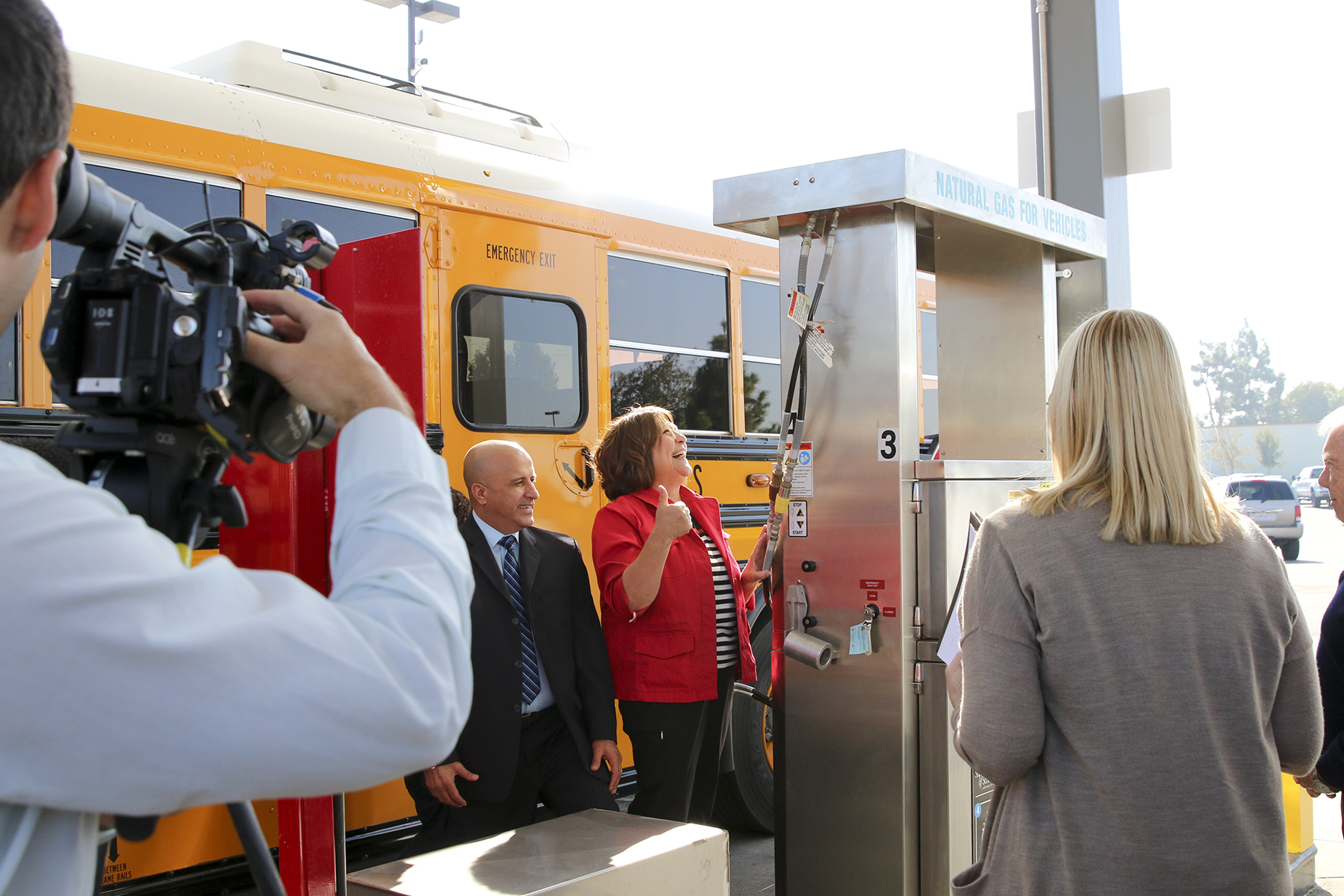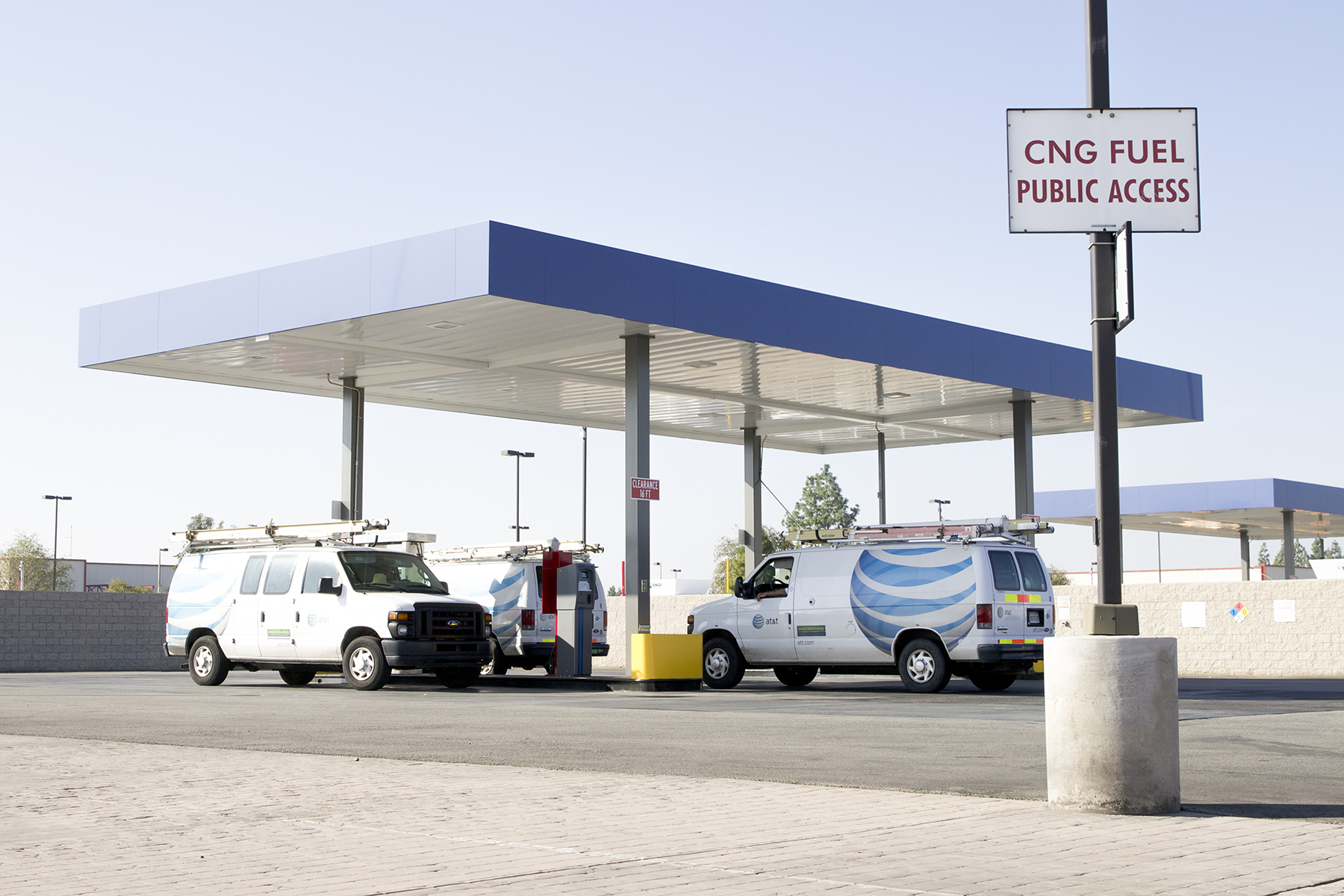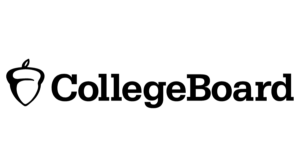
Compressed Natural Gas Station Expansion
Kern County Superintendent of Schools
Sending students to school in buses that run cleaner and use less expensive fuel not only improves regional air quality, it puts the savings back into the classroom and helps school financial officials breathe a little easier as well.
Enticed by the opportunity to go green while saving money, Kern County Superintendent of Schools (KCSOS) office began transitioning its school bus fleet to compressed natural gas in 1999.
Compressed natural gas (CNG) is an alternative to gasoline and diesel fuel that’s made by compressing natural gas to less than 1 percent of its volume. Natural gas vehicles show an average reduction in ozone-forming emissions of 80 percent compared to gasoline vehicles, according to the California Energy Commission.
Kern County Superintendent of Schools Christine Frazier and Seyed Sadredin, executive director and air pollution control officer of the Valley Air District, flip the switch on KCSOS’s CNG fueling station.
Scott Fieber, Energy Conservation Supervisor for the KCSOS Department of Maintenance and Operations, said, “We’re doing the right thing, because our air down here is so bad anything anybody can do is a good thing.”
Kern County has had a long-standing problem with air quality. In September 2015 Time.com called Bakersfield, “the worst place to breathe in America.”
KCSOS also operates a public CNG refueling station at its maintenance facility near Highways 58 and 99 – one of only two public CNG stations in the entire Bakersfield area – that station generates a profit for KCSOS. “That money goes back into the classroom to benefit our students,” Fieber said.
KCSOS has taken advantage of grant opportunities to grow its fleet of 60 CNG buses and its fueling station. For phase one of its CNG expansion effort, completed in December 2015, KCSOS received $2 million in grants from the San Joaquin Valley Air Pollution Control District and the Rose Foundation.
The phase one expansion included adding two new compressors, fast-fill CNG dispensers, shade canopies with LED lighting, and 46 time-fill hoses.
The time-fill hoses are placed on posts at the sites where drivers park their buses. At the end of their shifts, drivers can connect the fueling system to their buses and walk away, freeing up their time to do other things. Previously, drivers would have to drive to a fuel island and wait in line to fill up.
Phase 2 of the CNG expansion, which started this August, is being funded by $1.75 million in grants from the U.S. Department of Transportation and the California Energy Commission. Fieber said it’s scheduled to be completed by February 2017.
This next phase will include an additional compressor, storage tanks, another fast-fill dispenser, eight new time-fill hoses, and a portable CNG refueling trailer.
With their portable refueler, they will be able to station it out at school district sites to fill their buses. This will allow districts that would like to add CNG buses to their fleets but they are too far away from the facility to transition to CNG.
The shift from diesel to CNG required some additional training for mechanics, Fieber said, but maintenance on the new buses has gone smoothly since their engines are cleaner.
Fieber said KCSOS is also starting to convert its “white fleet” vehicles, including maintenance pick-ups, service trucks and kitchen delivery vans. Costs for purchasing new vehicles will be recouped, thanks to generous state and federal incentives to purchase CNG vehicles and cost savings from the less expensive fuel.
The price per gallon for CNG in mid-August was around $2.30, according to CNGPrices.com.
The use of alternative fuels for school buses nationwide continues to increase, although about 78 percent of new buses sold in 2015 still run on diesel fuel, according to School Bus Fleet magazine. Propane, another alternative fuel, accounts for 5 percent of new school bus sales, gasoline 16 percent and CNG 1 percent.
Los Angeles Unified School District has the largest fleet of CNG school buses in the state. The district estimates that its 475 CNG buses have reduced greenhouse gas emissions by 2,595 metric tons, or 7.5 percent, since 2007.
For more information:
• View a map of public CNG fueling stations created by the California Natural Gas Vehicle Coalition here.
• The California Energy Commission outlines the pros and cons of CNG vehicles here, in addition to providing information about funding opportunities for alternative fuel projects.
• The U.S. Department of Energy’s Alternative Fuels Data Center offers information about laws and incentives, fueling stations, costs and California case studies.





